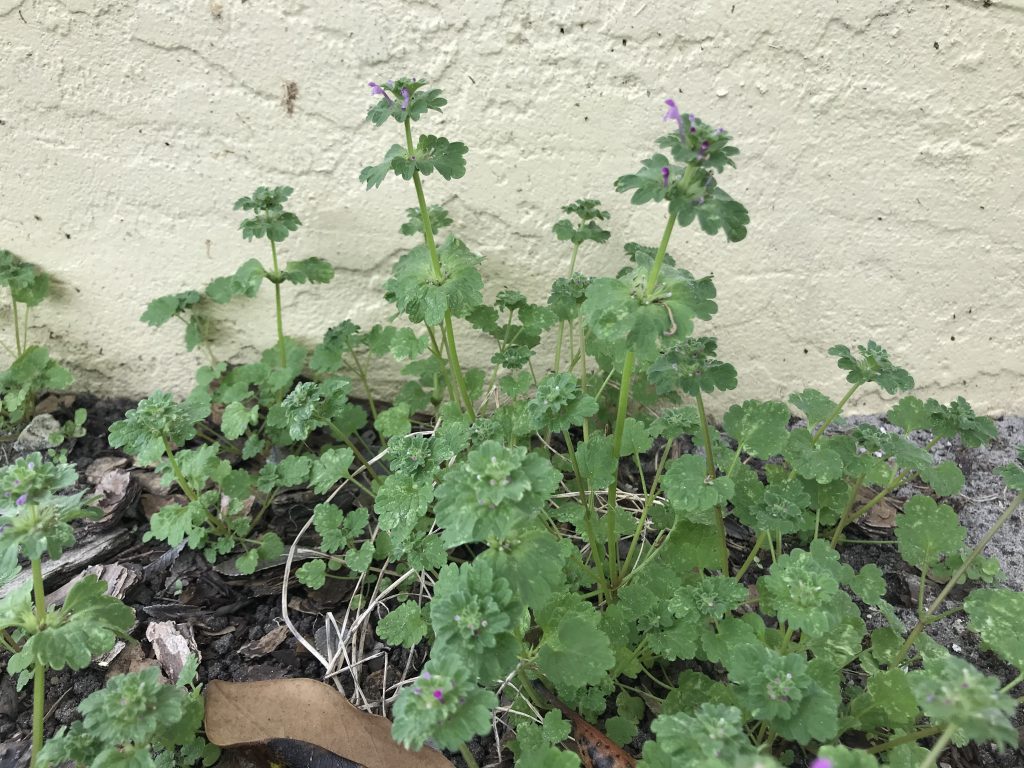
In time Henbit can get a foot high. Photo by Green Deane
When lawns aren’t mowed food grows. The weather’s been good and our winter plants are happy. In foraging classes these last two weeks weve seen Sheep’s Sorrel, Oxalis, Pellitory, Black Medic, Wild Geraniums, Horsemint, Chickweed and Henbit. The latter was a favored spring time green with Native Americans because it’s mild rather than peppery. and while in the mint family it is not minty. It’s edible raw or cooked. An edible relative, “Dead Nettle” looks very similar but is more purple. Henbit is called “Henbit” because chickens like it. It’s usually found in sunny, non-arid places. To read more about Henbit go here. Surprisingly what we haven’t seen yet is Stinging Nettle. Perhaps the nights have not been cool enough. Fast growing it’s usually around for a couple of months or so.
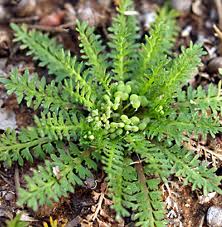
Swinecress is an easy to identify winter mustards.
During the classes seasonal mustards were also on display. Poor Man’s Pepper Grass is everywhere. Hairy Bittercress was found nearby as was Swine Cress (article here, new video here.) Also well-represented this past week was Shepherd’s Purse, Capsella bursa-pastoris, a much milder relative of Poor Man’s Pepper Grass. They have similar blossoms but differently shaped leaves and seed pods. The Shepherd’s pods look more like hearts than “purses.” One interesting aspect about Shepherd’s Purse is that I personally have never seen it growing south of the Ocala area. It’s found in 18 northern counties of Florida, one west central Florida county, Hillsborough, one southern Florida county, Dade, and throughout North America. It’s just kind of sparse in the lower half of the state. Also not see yet this season is Western Tansy Mustard. You find it in dry, sandy places like corrals.
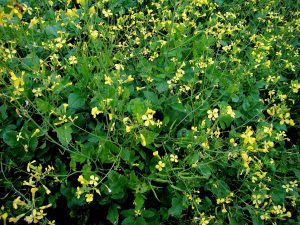
Wild Radish and Mustard are in blossom now. Photo by Green Deane
Driving back on the Beach Line” from our Lori Wilson Park meet up we saw miles of wild mustard growing roadside, like a light yellow hedge. Mustards like chilly weather, or at least locally they do. You can see Wild Mustards and Wild Radish not only along roadsides now but in various fields from farm land to ignored citrus groves. The two species are used interchangeably and look similar. However Wild Radishes tend to be serpentine rather than straight and tall like Wild Mustard. They also have lumpy seed pods, or, more lumpy than mustard seed pods. Usually you will find a stand of one or the other. I don’t recall finding both in the same patch. Blossom colors can range from yellow to white with streaks of purple. But the leaves always have the biggest lobe on the end farthest from the plant. Look for them in sunny areas with fertile soil. Not native they came from Eurasia in the 1700s. And note the seeds can remain viable in the soil for up to 60 years. To read more Wild Radish go here, and for Wild Mustard, here.
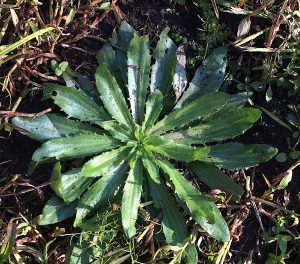
Our native plantain, Plantago P. virginiana. Photo by Green Deane
There are Plantains that look like tough bananas and there are Plantains that are low and leafy plants. They are not related. Just two different groups with the same common name. Low-growing Plantains can be native or non-native. The one pictured right is native, the Dwarf Plantain. As a genus the plants are well-known. The leaves are edible raw when young. As they age they become more bitter and stringy. Cooking makes them palatable up to a point. Then they move into the astringent medical realm. As such they are used on bites, stings and to help puncture wounds heal. The seeds are edible once produced and are the source of the commercial dietary fiber, psyllium. When finely ground the seeds are sold under the brand name Metamucil. There are numerous species of Plantagos (Plantains) with at least five common locally, P. virginiana, P. major, P. lanceolata and P. rugelii the latter which strongly resembles P. major. (P. rugelii is pink at the base of the stem, P. major is not.) They are all used the same way. One problem beginning foragers have is confusing young Oakleaf Fleabane leaves for Dwarf Plantain leaves (they are both rosette-ish, low-growing green leaves, hairy with fibrous threads in the stem.) But the Dwarf Plantain is essentially a long skinny hairy leaf with a few teeth. The Oakleaf Fleabane is much fatter, has lobes, and does resemble oak leaves found on northern oaks. You can read about the Plantains here and I have a video here.

Classes are held rain or shine (but not during hurricanes.)
Foraging Classes: Sticking to the east coast this weekend with classes in West Palm Beach and Port Orange which is near Daytona Beach.
Saturday January 8th, Dreher Park, 1200 Southern Blvd., West Palm Beach, 33405. 9 a.m to noon, meet just north of the science center.
Sunday January 9th, Spruce Creek Park, 6250 Ridgewood Ave. Port Orange, 32127. 9 a.m. to noon, meet at the pavilion.
Saturday January 15th, Bayshore Live Oak Park, Bayshore Drive. Port Charlotte, meet at the parking lot at Bayshore and Ganyard, 9 a.m. to noon.
Sunday January 16th, Mead Garden: 1500 S. Denning Dr., Winter Park, FL 32789. Meet at the bathrooms, 9 a.m. to noon. The entrance is on South Denning. Some GPS directions get it wrong and put it on S. Pennsylvania.
Sunday February 6th, John Chestnut County Park: 2200 East Lake Road, Palm Harbor, FL 34685. Meet at the trail head of the Peggy Park Nature Walk, pavilion 1 parking lot. 9 a.m. to noon.
For more information, to pre-pay or sign up go here.
The weather was pleasant and the turnout large for our visit to Lori Wilson Park in Cocoa Beach last weekend. I arrived at the park about 8 a.m. and wandered around looking at plants for the 10 a.m. walk. How unusual is that behavior, looking at plants in a park? Someone called the police and said I was hiding in the bushes and carrying a rifle (all I had was a phone, not even a walking stick.) Anyway… seven officers showed up, driving across the lawn no less. I didn’t know the Town of Cocoa Beach had that many officers and on a Sunday morning no less. After no rifle was found I got a lecture about staying on the paths.
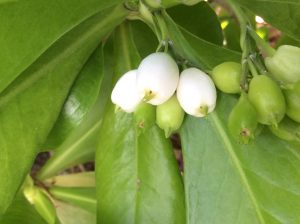
Florida native Snowberries/Snowbells. Photo by Green Deane
The second surprise of the day were two fruiting Natal Plums, one with easy access. If the officers had arrived then my defense would have been I was removing seeds of an invasive species from a protected native habitat. As it was we had a good taste of fruit, which is actually a commercial crop. The day also had a third surprise, Snowberries/Snowbells. It was only the second time in decades I had seen them and their name embarrassingly eluded me. Snowberries are Chiococca alba, which in Greek means Snow Berries White. Oddly it’s a Florida native in the coffee family (no it is not edible, and has been used to make folks throw up.) I last saw them on Marco Island (southwest Florida.) Most references say they are found only in south Florida other say they are found around most of the state’s coast then west to Texas then southward. As they are snow white they could make an attractive plant in the right location.

Green Deane videos are now available on a USB.
My nine-DVD set of 135 videos has been phased out and replaced by a 170-video USB. The USB videos are the same videos I have on You Tube. Some people like to have their own copy. The USB videos have to be copied to your computer to play. If you want to order the USB go to the DVD/USB order button on the top right of this page or click here. That will take you to an order form. Or you can make a $99 donation, which tells me it is for the USB (include a snail-mail address.) I’d like to thank all of you who ordered the DVD set over the years which required me to burn over 5,000 DVDs individually. I had to stop making them as few programs now will read the ISO files to copy them.

Green Deane Forum
Want to identify a plant? Perhaps you’re looking for a foraging reference? You might have a UFO, an Unidentified Flowering Object, you want identified. On the Green Deane Forum we — including Green Deane and others from around the world — chat about foraging all year. And it’s not just about warm-weather plants or just North American flora. Many nations share common weeds so there’s a lot to talk about, such as the one to the left. There’s also more than weeds. The reference section has information for foraging around the world. There are also articles on food preservation, and forgotten skills from making bows to fermenting food. Recent topics include: California Wild Mushroom Parties, A Good Reason To Eat Wild Garlic, Black Walnuts and Amaranth, Sea Salt and Plastic, Wild Mustard? Heavy Metals. Oriental Persimmons. What is it? Pine Cough Drops and Needles, Skullcap, Malodorous Plant? Another NJ Tree, Maypop? Roadside Plant, Unknown in Sudan, Please Help Identify, and Preserving Prickly Pear Bounty. You can join the forum by clicking on the button on the upper right hand side of this page.
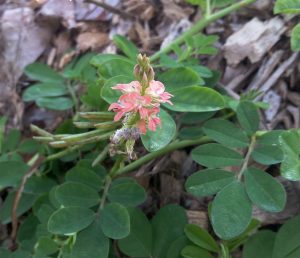
Creeping Indigo is toxic to many foraging animals. Photo by Top Tropicals.com
Veterinarians annually issue a warning this time of year about a plant that is makes horses sick, Creeping Indigo, Indigofera spicata. Cold weather causes this pea relative to blossom pink, making it a little easier to see. Unfortunately it is a plant favored by horses with at least one dying and others sickened. (This highlights that relying on instinctual means to avoid toxic plants is not too reliable for animals or man.) As with many toxic and invasive species Creeping Indigo was intentionally brought to Florida in 1925. The University of Florida imported it from Sri Lanka (then Ceylon) for agricultural experiments. When it killed one of two rabbits the testing stopped but the weed stayed (the second rabbit recovered after the Creeping Indigo was removed from its diet.) Within eight years Creeping Indigo was raising concerns about poisoning farm animals.
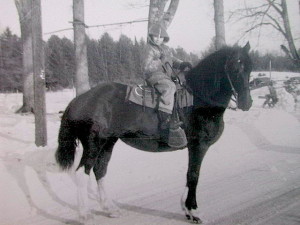
That’s Green Deane as a sprout on “Ginger.” Home included five horses, rabbits, chickens, ducks, a multitude of dogs and cats and an occasional pet squirrel.
Besides horses, it is also toxic to cattle, sheep, goats, guinea pigs, the aforementioned rabbits, and birds. Pigs won’t eat it which calls into question reports that it does not bother pigs. Someone might be assuming that since pigs aren’t being reported sick from eating Creeping Indigo they aren’t bothered by it whereas it could equally be that because pigs avoid it there are no reports porcine poisoning. The prime toxin in Indigofera spicata is indospicine which “inhibits the incorporation of arginine and other amino acids in liver cells result in liver insufficiency.”
This is my weekly newsletter #489. If you want to subscribe to this free newsletter you can find the sign-up form in the menu at the top of the page. My website, which is data secure, has over 1500 plants on it in some 428 articles. I wrote every one myself, no cut and paste.
To donate to the Green Deane Newsletter click here.

